Category: Rebuilding Business
Navigating England’s Economic Trends: Insights for 2024

Decoding England’s Economic Trends: A Glimpse into 2024
As we step into 2024, understanding the economic trends shaping England’s landscape is pivotal for businesses, policymakers, and individuals alike. This article delves into key insights, providing a comprehensive overview of England’s economic trends and what they mean for the year ahead.
Post-Pandemic Resilience: A Beacon of Hope
The lingering effects of the global pandemic have significantly impacted economies worldwide, and England is no exception. However, signs of resilience are emerging. With vaccination efforts underway and economic recovery measures in place, England’s economy is poised for a rebound. As businesses adapt to the new normal, the resilience shown during challenging times becomes a beacon of hope for sustained recovery.
Digital Transformation: A Driving Force
One of the prominent trends shaping England’s economic landscape is the acceleration of digital transformation. The pandemic has accelerated the adoption of digital technologies across industries. From remote work solutions to e-commerce innovations, businesses are embracing digital tools to enhance efficiency, reach a wider audience, and stay competitive. This digital shift is expected to continue influencing economic activities throughout 2024.
Green Economy Initiatives: A Sustainable Focus
Sustainability is at the forefront of England’s economic agenda. The commitment to achieving net-zero carbon emissions by 2050 is steering the country towards green economy initiatives. Investments in renewable energy, sustainable infrastructure, and eco-friendly practices are not only environmentally responsible but also contribute to job creation and economic growth.
Trade Dynamics and Global Partnerships
England’s economic outlook is intricately connected to global trade dynamics. As the country establishes new trade relationships post-Brexit, the focus is on diversifying trade partners and securing mutually beneficial agreements. Navigating the complexities of international trade will be a key determinant of England’s economic success in 2024 and beyond.
Innovation and Research & Development
Fostering innovation and investing in Research & Development (R&D) are integral components of England’s economic strategy. The emphasis on technological advancements, scientific research, and innovation hubs is driving economic diversification. The synergy between government initiatives, academic institutions, and private enterprises is propelling England towards becoming a hub for cutting-edge research and innovation.
England Economic Trends: A Resource for Insight
For a deeper dive into the nuances of England’s economic trends in 2024, explore England Economic Trends. This resource provides valuable insights, analysis, and expert opinions to guide businesses and stakeholders in navigating the evolving economic landscape.
Challenges and Opportunities in the Labor Market
The labor market plays a pivotal role in economic trends, and England is experiencing both challenges and opportunities. The hybrid work model, skills gaps, and evolving job demands are reshaping the workforce landscape. Government initiatives focusing on upskilling and reskilling are addressing these challenges, presenting opportunities for individuals to adapt to the changing job market.
Housing Market Dynamics: A Balancing Act
The housing market in England reflects a delicate balancing act. While demand remains high, concerns about affordability and housing supply persist. Government policies and initiatives aimed at addressing these challenges are influencing the real estate landscape. Observing how these dynamics unfold will be crucial for understanding broader economic trends.
Consumer Behavior and Spending Patterns
Understanding consumer behavior is essential in gauging economic trends. The shift in consumer preferences, spending patterns, and the rise of conscious consumerism are impacting various industries. Businesses that align with changing consumer expectations and values are likely to thrive. Monitoring these shifts provides valuable insights into the future trajectory of England’s economy.
Conclusion: Navigating the Economic Landscape
In conclusion, navigating England’s economic landscape in 2024 involves a nuanced understanding of various trends and dynamics. From embracing digital transformation and sustainable practices to addressing labor market challenges and housing dynamics, businesses and individuals alike need to adapt to these evolving trends. Explore the provided resource, England Economic Trends, for ongoing insights and analysis as England continues its journey through the economic landscape of 2024.
Luxury Living: Business Lakefront Estates

Luxury Living: Business Lakefront Estates
Embrace the epitome of opulence with Business Lakefront Estates, where sophistication meets serenity on the shores of breathtaking lakes. Discover the allure of these exclusive properties and the unique blend of business and leisure they offer.
Unrivaled Elegance in Design
Business Lakefront Estates boast unrivaled elegance in architectural design. From contemporary masterpieces to timeless classics, these estates are a testament to exquisite craftsmanship and attention to detail. Each property is a harmonious blend of luxury and functionality, creating an ambiance that speaks to the discerning taste of successful individuals.
Breathtaking Lake Views
One of the defining features of Business Lakefront Estates is the breathtaking lake views that accompany these magnificent properties. The tranquil beauty of the water, whether it’s a serene lake or a majestic waterfront, becomes an integral part of daily life. These estates offer a unique opportunity to wake up to stunning vistas and unwind with unparalleled sunset views.
Secluded Serenity for Business Retreats
Beyond the luxurious amenities, Business Lakefront Estates provide a secluded serenity ideal for business retreats. The tranquil environment fosters focused productivity, making these estates the perfect backdrop for strategic planning sessions, executive meetings, and team-building activities. A retreat to the lakeside offers a refreshing break from the demands of corporate life.
State-of-the-Art Amenities for Networking
Business Lakefront Estates are equipped with state-of-the-art amenities that go beyond the ordinary. These properties feature conference rooms, business centers, and cutting-edge technology to facilitate seamless networking and business interactions. The fusion of luxurious living spaces and professional amenities creates an environment conducive to both work and relaxation.
Exclusive Entertainment Spaces
Luxury living extends to exclusive entertainment spaces within Business Lakefront Estates. From private theaters and wine cellars to expansive outdoor patios, these properties redefine the meaning of entertainment. Residents can host lavish gatherings, corporate events, or intimate celebrations, elevating their lifestyle to new heights.
Waterfront Access for Leisure and Recreation
Beyond business, Business Lakefront Estates provide unparalleled waterfront access for leisure and recreation. Residents can indulge in water activities such as boating, kayaking, or simply lounging by the shore. The estates offer a perfect blend of work and play, allowing individuals to rejuvenate in the lap of luxury.
Customization to Suit Business Preferences
Business Lakefront Estates offer the flexibility of customization to suit individual business preferences. Whether it’s a dedicated home office with a lake view, a personal library, or a spa retreat for relaxation, these estates cater to the unique needs and aspirations of business leaders. Customizable spaces allow residents to shape their environment according to their lifestyle.
Security and Privacy in Tranquil Surroundings
Privacy and security are paramount in Business Lakefront Estates. Tucked away in tranquil surroundings, these properties provide a secure retreat where residents can enjoy peace of mind. The gated communities and advanced security features ensure that business leaders can focus on their professional endeavors without compromising on privacy.
Investment Potential and Prestige
Owning a property in Business Lakefront Estates not only signifies luxury but also holds significant investment potential. These estates are prestigious addresses that enhance one’s professional image and stature. The rarity and exclusivity of lakefront living contribute to the enduring value of these properties.
Elevate Your Lifestyle with Business Lakefront Estates
In conclusion, Business Lakefront Estates redefine luxury living by seamlessly blending business and leisure. With stunning designs, breathtaking views, and a host of amenities, these estates offer a lifestyle of unparalleled sophistication. Explore the epitome of opulence at Business Lakefront Estates.
Forward-Thinking Workspaces: Progressive Workplace Dynamics

Catalyzing Success: Navigating Progressive Workplace Dynamics
In the ever-evolving landscape of work, progressive workplace dynamics are shaping the way businesses operate and employees engage. From innovative office designs to flexible work arrangements, the paradigm of work is undergoing a transformation. This article explores the key facets of progressive workplace dynamics and how they contribute to a more dynamic and fulfilling work environment.
Designing Spaces for Collaboration and Creativity
Progressive workplace dynamics place a strong emphasis on the physical workspace. Modern offices are designed to foster collaboration and creativity, with open floor plans, collaborative workstations, and designated spaces for brainstorming sessions. The goal is to create an environment that encourages spontaneous interactions and facilitates the free flow of ideas among team members.
Explore Progressive Workplace Dynamics for insights into creating innovative and collaborative workspaces.
Flexible Work Arrangements: Embracing Remote and Hybrid Models
Flexibility is at the core of progressive workplace dynamics. In 2024, businesses are embracing remote work and hybrid models, allowing employees to balance work and life more effectively. This flexibility not only accommodates diverse work styles but also enhances employee satisfaction and productivity. The ability to work from anywhere is a powerful driver of talent attraction and retention.
Technology as an Enabler: Connecting Distributed Teams
In the era of progressive workplace dynamics, technology plays a pivotal role in connecting distributed teams. Video conferencing, collaboration platforms, and project management tools facilitate seamless communication and collaboration among team members, regardless of their physical location. The digital infrastructure ensures that remote and in-office employees can work together efficiently.
Employee Well-being at the Forefront: Health and Happiness
Progressive workplaces prioritize the well-being of employees. Health and happiness are integral to the overall workplace experience. Companies are investing in wellness programs, mental health support, and ergonomic office setups to ensure that employees thrive both professionally and personally. A focus on well-being contributes to a positive workplace culture and enhances employee engagement.
Diversity and Inclusion Initiatives: Fostering a Sense of Belonging
Creating an inclusive workplace is a key tenet of progressive workplace dynamics. In 2024, businesses are actively fostering diversity and inclusion initiatives to ensure that every employee feels a sense of belonging. Diverse teams bring varied perspectives and ideas, fostering innovation and creativity. Inclusive workplaces are not only ethically sound but also contribute to business success.
Continuous Learning and Development: Empowering the Workforce
The rapid pace of change in the business landscape requires a commitment to continuous learning. Progressive workplace dynamics prioritize employee development through training programs, mentorship opportunities, and upskilling initiatives. Empowering the workforce with the skills needed for the future not only benefits individual career growth but also strengthens the overall organizational capabilities.
Agile Work Practices: Adapting to Change Efficiently
Agility is a hallmark of progressive workplace dynamics. Agile work practices enable organizations to adapt to change efficiently. From agile project management methodologies to flexible team structures, businesses are streamlining processes to respond quickly to market dynamics. This adaptability is crucial for staying competitive in an ever-changing business environment.
Environmental Sustainability: Corporate Responsibility
In 2024, corporate responsibility extends to environmental sustainability. Progressive workplaces are adopting eco-friendly practices, from energy-efficient office designs to sustainable supply chain choices. Businesses recognize the impact of their operations on the environment and are taking steps to reduce their carbon footprint. Environmental sustainability aligns with the values of employees and customers alike.
Explore Progressive Workplace Dynamics for insights into creating innovative and collaborative workspaces.
Conclusion: Shaping the Future of Work
In conclusion, progressive workplace dynamics are not just a trend but a fundamental shift in how we approach work. The combination of innovative spaces, flexible arrangements, and a focus on employee well-being is shaping the future of work. As businesses navigate the complexities of the modern work environment, embracing progressive workplace dynamics becomes a strategic imperative for success. For more insights and strategies, explore Progressive Workplace Dynamics.
Business Mixed-Use Developments: A Fusion of Commerce and Lifestyle

Business Mixed-Use Developments: A Fusion of Commerce and Lifestyle
In the realm of urban planning and real estate, the concept of mixed-use developments has gained significant traction. These developments seamlessly integrate various elements, offering a blend of commercial, residential, and recreational spaces to create vibrant and dynamic environments.
The Evolution of Mixed-Use Developments
Mixed-use developments have evolved beyond traditional city planning models. The concept originated as a response to the urban sprawl phenomenon, aiming to create more sustainable and livable communities. Over time, the focus has shifted towards incorporating business spaces into these developments, giving rise to Business Mixed-Use Developments.
Integration of Commercial Spaces
One defining feature of Business Mixed-Use Developments is the intentional integration of commercial spaces. These developments house a variety of businesses, from retail establishments to office spaces and even hospitality venues. The proximity of these commercial entities fosters a synergistic relationship, creating convenience for residents and employees alike.
Residential Components for Live-Work-Play Lifestyle
Beyond commerce, these developments often include residential components, promoting a live-work-play lifestyle. Residents have the convenience of living in close proximity to their workplaces, reducing commute times and enhancing work-life balance. The residential elements contribute to the overall vibrancy of the community.
Benefits for Businesses
For businesses, being part of a mixed-use development brings several advantages. The constant flow of residents, employees, and visitors creates a built-in customer base. Additionally, the diverse range of services and amenities within the development can attract a broader demographic, providing businesses with increased visibility and potential for growth.
Enhanced Community Engagement
Business Mixed-Use Developments promote community engagement by offering spaces for social interactions and cultural activities. Common areas, parks, and event spaces are integrated into the design, encouraging residents and visitors to connect. This enhanced sense of community contributes to the overall appeal of these developments.
Sustainability and Green Spaces
Many Business Mixed-Use Developments prioritize sustainability by incorporating green spaces and eco-friendly design principles. The integration of parks, communal gardens, and energy-efficient buildings not only enhances the aesthetic appeal but also aligns with the growing emphasis on environmentally conscious urban planning.
Challenges and Solutions
While Business Mixed-Use Developments offer numerous benefits, they also present challenges, such as managing the diverse needs of different stakeholders and ensuring a harmonious coexistence of residential and commercial spaces. Solutions often involve thoughtful design, effective zoning regulations, and community involvement in the planning process.
Technology Integration
The modern Business Mixed-Use Development is also characterized by the integration of technology. Smart building systems, efficient energy management, and digital connectivity are incorporated to enhance the overall experience for residents, workers, and businesses. These technological advancements contribute to the overall appeal and competitiveness of these developments.
Case Studies of Success
Examining case studies of successful Business Mixed-Use Developments provides valuable insights into the factors contributing to their effectiveness. From iconic projects revitalizing urban centers to innovative designs that prioritize sustainability, these case studies offer lessons for future developments seeking to strike a balance between commerce and lifestyle.
Future Trends and Possibilities
As the concept of Business Mixed-Use Developments continues to evolve, future trends are likely to focus on even more innovative and sustainable designs. The integration of advanced technologies, a stronger emphasis on wellness-oriented spaces, and increased flexibility in land use are among the possibilities shaping the future of these dynamic urban environments.
Exploring Business Mixed-Use Developments
For an in-depth exploration of the dynamic world of Business Mixed-Use Developments, visit Business Mixed-Use Developments. Discover the synergy between commerce and lifestyle, the innovative designs shaping urban landscapes, and the potential for creating thriving, interconnected communities.
Business 2024: Culinary Creativity Redefining Gastronomic Experiences

Unveiling the Culinary Revolution: Business 2024 Culinary Creativity
In the realm of business and gastronomy, the year 2024 heralds a new era of culinary creativity. As businesses evolve, the intersection of innovation and culinary arts takes center stage, redefining gastronomic experiences and setting the stage for a culinary revolution.
Innovation at the Core: Business 2024 Culinary Trends
At the heart of Business 2024 Culinary Creativity is a commitment to innovation. From avant-garde cooking techniques to inventive flavor pairings, chefs are pushing the boundaries of conventional culinary practices. This commitment to innovation is not only transforming dishes but also shaping the entire dining experience.
The Fusion of Technology and Culinary Arts
In 2024, technology and culinary arts are becoming inseparable partners. From molecular gastronomy to high-tech kitchen equipment, businesses are integrating cutting-edge technology to enhance the culinary process. This fusion not only streamlines operations but also opens up new possibilities for creative expression in the kitchen.
Sustainability and Culinary Responsibility
Business 2024 Culinary Creativity goes beyond taste; it embraces sustainability and culinary responsibility. Chefs and businesses are increasingly sourcing locally, reducing food waste, and adopting eco-friendly practices. This commitment to sustainability aligns with the growing awareness of consumers who seek both a delightful dining experience and a socially responsible one.
Culinary Storytelling: Beyond the Plate
In the evolving landscape of Business 2024, culinary creativity extends beyond the plate to culinary storytelling. Chefs are incorporating narratives into their menus, drawing inspiration from cultural traditions, personal experiences, and the journey of ingredients. This storytelling approach enriches the dining experience, creating a connection between the chef, the food, and the diner.
Personalization and Customization in Dining
Customization is a key theme in Business 2024 Culinary Creativity. Restaurants and food businesses are offering personalized dining experiences, allowing customers to tailor their dishes to individual preferences. From build-your-own menus to chef-curated personalized meals, this trend caters to the diverse tastes of modern consumers.
Collaborations Redefining Culinary Borders
In the spirit of innovation, collaborations between chefs, restaurants, and even industries are redefining culinary borders. Business 2024 sees chefs teaming up to create unique dining experiences, blending flavors and techniques from different culinary traditions. These collaborations not only spark creativity but also bring a sense of excitement to the culinary scene.
Immersive Dining Experiences: Beyond Eating
Business 2024 Culinary Creativity transforms dining into an immersive experience. From interactive cooking classes to pop-up dining events, businesses are offering more than just meals; they’re providing memorable experiences. This shift in focus from eating to experiencing resonates with consumers seeking a holistic and engaging culinary adventure.
Technology Link: Explore Business 2024 Culinary Creativity
To explore the dynamic world of Business 2024 Culinary Creativity, visit woazala.my.id. This platform serves as a hub for culinary enthusiasts, offering insights into the latest trends, innovative techniques, and the vibrant landscape where business and gastronomy converge. Dive into the culinary revolution and discover how creativity is reshaping the business of food.
Conclusion: Embracing the Culinary Revolution
In conclusion, Business 2024 Culinary Creativity is not just about what’s on the plate; it’s a revolution that touches every aspect of the dining experience. From innovative techniques and sustainability practices to immersive storytelling, the culinary landscape is evolving. Embracing this revolution is not only a business strategy but a celebration of the art and creativity that make dining an extraordinary experience.
Innovate Business 2024 Analytics: Unleashing Strategic Insights

Unleashing Strategic Insights: Navigating the Business Landscape in 2024
In the fast-paced world of business, staying ahead requires not only innovation but also a keen understanding of analytics. As we dive into 2024, let’s explore how businesses are leveraging cutting-edge analytics to innovate and thrive.
The Power of Data-driven Decision Making
Innovative businesses understand that data is a valuable asset. Analytics in 2024 is not just about collecting information; it’s about extracting meaningful insights. Companies are harnessing the power of data-driven decision-making to identify trends, understand customer behavior, and make strategic choices that drive success.
Predictive Analytics: Shaping Future Outcomes
Predictive analytics has emerged as a game-changer for businesses. By analyzing historical data and patterns, companies can now make informed predictions about future trends. This not only aids in proactive decision-making but also allows for the anticipation of market shifts, ensuring businesses are well-prepared for what lies ahead.
AI and Machine Learning Integration
In 2024, the integration of artificial intelligence (AI) and machine learning (ML) into analytics processes is becoming more widespread. These technologies enhance the speed and accuracy of data analysis, providing businesses with real-time insights. From personalized customer experiences to operational efficiency, AI and ML are driving innovation across various sectors.
Enhancing Customer Experiences
Customer-centricity remains a focal point for businesses aiming to innovate. Analytics tools are being employed to understand customer preferences and behavior, enabling the creation of tailored experiences. Businesses that prioritize customer satisfaction through analytics-driven insights are gaining a competitive edge in the market.
Cybersecurity Analytics: Safeguarding Business Assets
As technological advancements continue, so does the need for robust cybersecurity. Innovate Business 2024 Analytics plays a crucial role in identifying and mitigating cyber threats. Businesses are investing in advanced analytics tools to monitor, detect, and respond to potential security breaches, ensuring the protection of sensitive data.
Operational Efficiency through Analytics
Efficiency is the cornerstone of a successful business. Analytics is streamlining operations by identifying areas for improvement, optimizing workflows, and reducing unnecessary costs. This focus on operational efficiency is allowing businesses to allocate resources strategically and drive overall productivity.
Challenges and Opportunities in Analytics Adoption
While the benefits of analytics are vast, businesses also face challenges in its adoption. From data privacy concerns to the need for skilled professionals, navigating these obstacles is essential. However, overcoming these challenges presents opportunities for businesses to differentiate themselves and establish a strong analytics-driven foundation.
Innovate Business 2024 Analytics is not just a buzzword; it’s a strategic imperative for businesses aiming to thrive in the current landscape. Whether you are a startup or an established enterprise, leveraging analytics can unlock new possibilities. Explore the potential of analytics in shaping your business’s future at woazala.my.id and stay at the forefront of innovation in 2024.
Why Social Media Marketing is a Must-Have for Any Successful Business
In the modern age of technology and the internet, communication channels have changed dramatically, and social media has emerged as a dominant force. Social media marketing (SMM) has become a must-have for any successful business that wants to reach a large and diverse audience, build a strong brand image, and increase revenue. In this article, we will explore why social media marketing has become an essential tool for businesses of all sizes and types.
1. Wider Reach
With over 3 billion active users worldwide, social media platforms like Facebook, Instagram, Twitter, and LinkedIn provide businesses with unparalleled access to a vast audience. Given the massive volume of activity on social media, businesses can reach a diverse set of people, survive cut-throat competition, and create awareness and visibility of their brand.
2. Targeted Advertising
Social media platforms offer businesses the opportunity to create and place highly targeted ads that can reach customers by specific demographics, interests, behaviors, and locations. With the power of advanced algorithms and analytics, businesses can gain reliable insights into their target audience’s behavior and preferences, which can help them craft effective sales and marketing campaigns.
3. Cost-Effective
Social media platforms offer businesses the opportunity to market to their target audience at a much lower cost than traditional advertising methods. With platforms like Facebook and Instagram, businesses can set their budget and choose their target audience carefully to maximize their return on investment.
4. Brand Reputation
Strong brand reputation is essential for the long-term growth and success of a business. Social media platforms have become powerful tools for businesses to build their online reputation, interact with customers directly, address concerns in real-time, and engage with their audience through authentic, engaging, and educational content.
5. Competitive Edge
Social media platforms offer businesses the opportunity to gain a competitive edge by keeping them connected and up-to-date with industry trends, best practices, and emerging technologies. With the ability to track their competitors’ activities, businesses can stay ahead of the curve and adapt their marketing strategies accordingly.
In conclusion, social media marketing has become an essential part of any successful business marketing plan. With the ability to reach a broader audience, target specific demographics, and build a strong brand reputation, businesses can drive sales, increase profitability, and create a loyal customer base. By staying connected with customers, tracking competitors’ activities, and leveraging emerging technologies, businesses can gain a competitive edge in the ever-evolving digital landscape.…
World Economy 2024: Business Expansion Dynamics

Navigating Global Opportunities: World Economy 2024 Business Expansion
The world economy in 2024 presents a landscape filled with both challenges and opportunities for businesses looking to expand their horizons. This article explores the dynamics of business expansion in this global context, shedding light on key factors and strategies for success.
Economic Outlook and Global Trends:
Understanding the current economic landscape is crucial for businesses planning expansion. In 2024, a nuanced understanding of global trends, market demands, and geopolitical considerations is essential. Staying abreast of economic indicators and forecasts enables businesses to make informed decisions in the ever-evolving world economy.
Strategies for Global Market Entry:
Expanding into international markets requires well-thought-out strategies. Whether through export, strategic partnerships, or establishing subsidiaries, businesses need to carefully assess their approach. Crafting a comprehensive market entry strategy tailored to the nuances of each target market is vital for successful business expansion.
Adapting to Cultural Diversity:
One of the challenges in global expansion is navigating diverse cultures. Businesses must be adept at adapting their products, services, and marketing strategies to align with the cultural nuances of each region. Embracing cultural diversity not only fosters better relationships but also enhances the acceptance of the brand in new markets.
Technological Integration and Innovation:
In 2024, technology plays a central role in global business expansion. Leveraging advanced technologies and fostering innovation is key to gaining a competitive edge. Businesses need to integrate digital solutions that streamline operations, enhance customer experiences, and position them as leaders in the global marketplace.
Risk Management in International Expansion:
Expanding globally comes with inherent risks, from regulatory challenges to currency fluctuations. Businesses must develop robust risk management strategies to navigate uncertainties. This involves comprehensive research, scenario planning, and the implementation of contingency measures to mitigate potential challenges.
Sustainability and Corporate Responsibility:
In the era of heightened environmental and social consciousness, businesses expanding globally must prioritize sustainability and corporate responsibility. Adopting ethical practices, reducing environmental impact, and contributing to local communities not only align with global expectations but also enhance the brand’s reputation in diverse markets.
Financial Planning and Resource Allocation:
Successful global expansion requires meticulous financial planning. Businesses must allocate resources efficiently, balancing the need for investment in new markets with maintaining financial stability. This involves evaluating the potential return on investment, optimizing cost structures, and ensuring a sustainable financial trajectory.
Strategic Alliances and Partnerships:
Building strategic alliances and partnerships is instrumental in navigating the complexities of global expansion. Collaborating with local businesses, industry partners, and government entities can provide valuable insights, regulatory support, and a foothold in new markets. These alliances contribute to a smoother entry and sustained growth.
Customer-Centric Approach in Global Markets:
Adopting a customer-centric approach is paramount when expanding globally. Understanding the unique needs and preferences of customers in different regions allows businesses to tailor their products and services accordingly. This not only enhances customer satisfaction but also fosters brand loyalty in diverse markets.
The Role of Government Policies and Regulations:
Government policies and regulations can significantly impact the success of global expansion. Businesses must stay informed about the regulatory environment in each target market, ensuring compliance and navigating any legal hurdles. Proactively engaging with local authorities can pave the way for smoother operations.
In conclusion, thriving in the world economy of 2024 requires a strategic and adaptive approach to business expansion. By considering economic trends, formulating thoughtful strategies, embracing diversity, and leveraging technology, businesses can position themselves for success on the global stage. For more insights on World Economy 2024 Business Expansion, visit this link.
The Affordable Way to Upgrade Your Home: Home Improvement Loans
As a homeowner, it’s natural to want to improve the look and functionality of your home. However, home improvements can be expensive, and not everyone has the resources to pay for them upfront. That’s where home improvement loans come in.
Home improvement loans are typically secured loans used to help homeowners finance renovations or repairs. There are many different types of home improvement loans available, including home equity loans, personal loans, and home improvement credit cards. Each of these options has its own benefits and drawbacks.
One of the most popular types of home improvement loans is a home equity loan. This type of loan allows homeowners to borrow against the equity they’ve built up in their homes. The interest rates for home equity loans are typically lower than those of other types of loans, and they often come with longer repayment terms.
Another option is a personal loan. Personal loans are unsecured, meaning borrowers don’t have to put up any collateral to secure the loan. Personal loans are often a good option for smaller home improvement projects, as they typically come with higher interest rates and shorter repayment terms than home equity loans.
If neither of these options works for you, you may also consider a home improvement credit card. These cards work like regular credit cards, but the interest rates are often lower and the rewards may be tailored specifically to home improvement projects. However, credit cards should be used with caution, as it’s easy to rack up high interest rates and fees if you don’t pay off the balance on time.
Regardless of which type of home improvement loan you choose, there are a few things to keep in mind. First, make sure you work with a reputable lender and read all the terms and conditions carefully before signing any agreements. You should also consider the total cost of the loan, including interest rates, fees, and any other charges.
Home improvement loans can be a great way to finance your renovation or repair project without breaking the bank. With a little research and careful financial planning, you can upgrade your home affordably and enjoy the benefits for years to come.…
Upgrade Your Appliances for Better Performance and Increased Home Value
Homeowners are always seeking ways to increase the value of their homes while also improving the functionality and performance of their appliances. One surefire way to achieve both of these goals is to upgrade your appliances. Upgrading your appliances improves the overall efficiency and performance of your home, all while increasing its value. Here are some ways that upgrading your appliances can improve your home in both the short and long term.
Energy Efficiency
Upgrading your appliances to more energy-efficient models can significantly reduce your energy bills. Newer appliances use less energy than older models, and many appliances now come with energy-saving features such as timers and sensors that help reduce overall energy consumption. When you upgrade your appliances, you also help to reduce your carbon footprint and contribute to a cleaner environment.
Better Performance
Older appliances may exhibit signs of wear and tear over time. You may notice that your current appliances are less efficient than what they used to be, making it difficult for you to use them properly. Upgrading your appliances to newer models with better performance capabilities improves the efficiency and reliability of your home appliances, allowing you to complete tasks quickly and easily. For instance, upgrading to high-performance refrigerators keeps your food fresh for longer periods while being energy-efficient. This decreases the cost of food wastage while also reducing the overall energy consumption of your home.
Increased Home Value
Upgrading your appliances instantly increases the value of your home. If you’re looking to sell your home in the future, you will attract potential buyers with modern and updated appliances. Home buyers are always looking for homes with energy-efficient and updated appliances, as it saves them money on their energy bills in the long run. The upgrade of appliances increases your home value and cuts the wait time to sell your home in competitive markets.
Better Style
Besides increasing the value and performance of your home, upgrading your appliances can give your home a modern touch. Older appliances could make your home less stylish, which can be a deal breaker for some people. Upgrading to stylish and modern appliances helps give your home a contemporary and high-end look. It provides the home with an up-to-date feel, which gives buyers the impression that your home was well-taken care of and is a worthy purchase.
In conclusion, upgrading your home appliances comes with numerous benefits, such as improved energy efficiency, increased home value, better performance, and an updated style. Additionally, modern appliances come with additional features that make them both more efficient and easy to operate. From smart ovens to refrigerators with built-in touchscreens, upgrading your appliances improves your quality of living while making a worthy return on your investment.…







